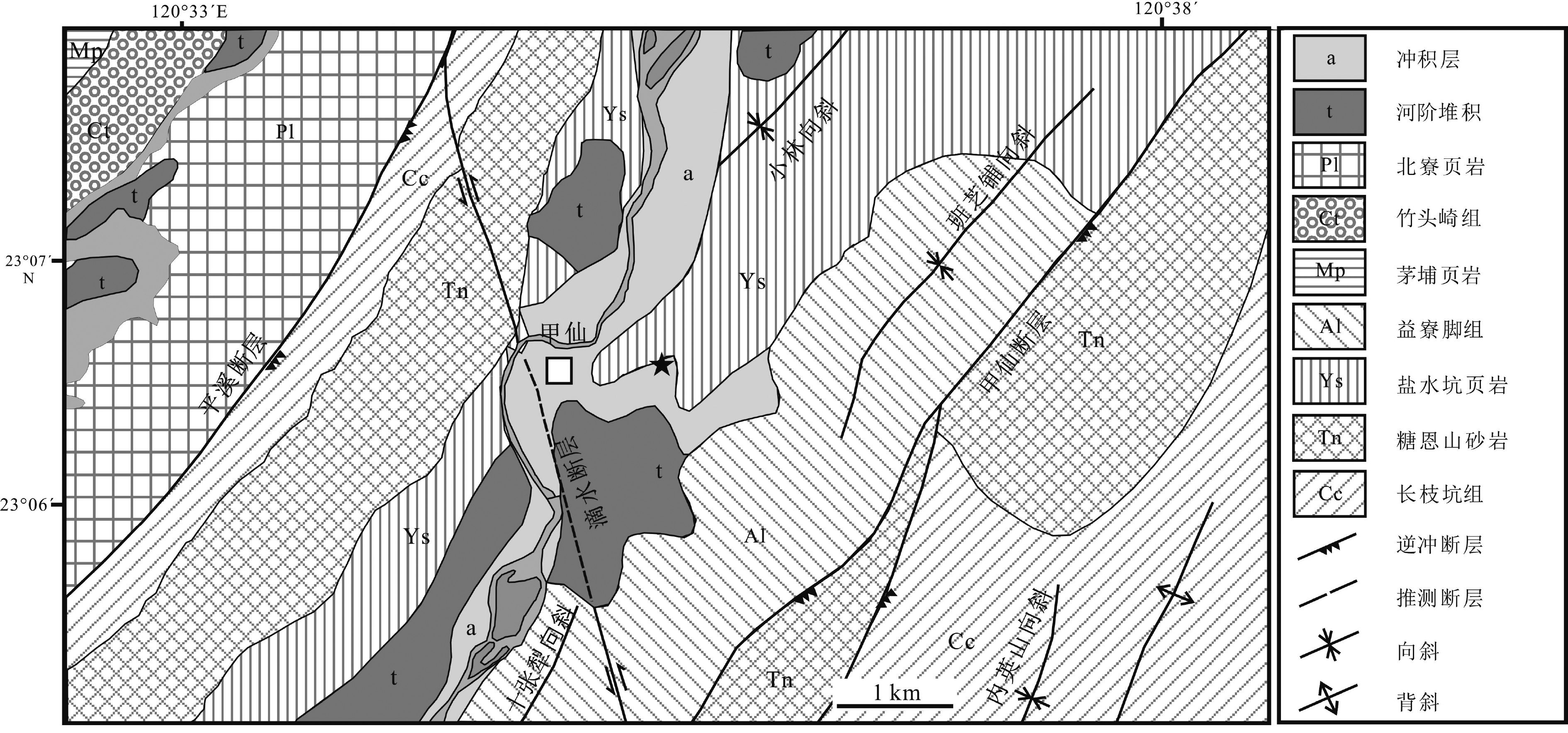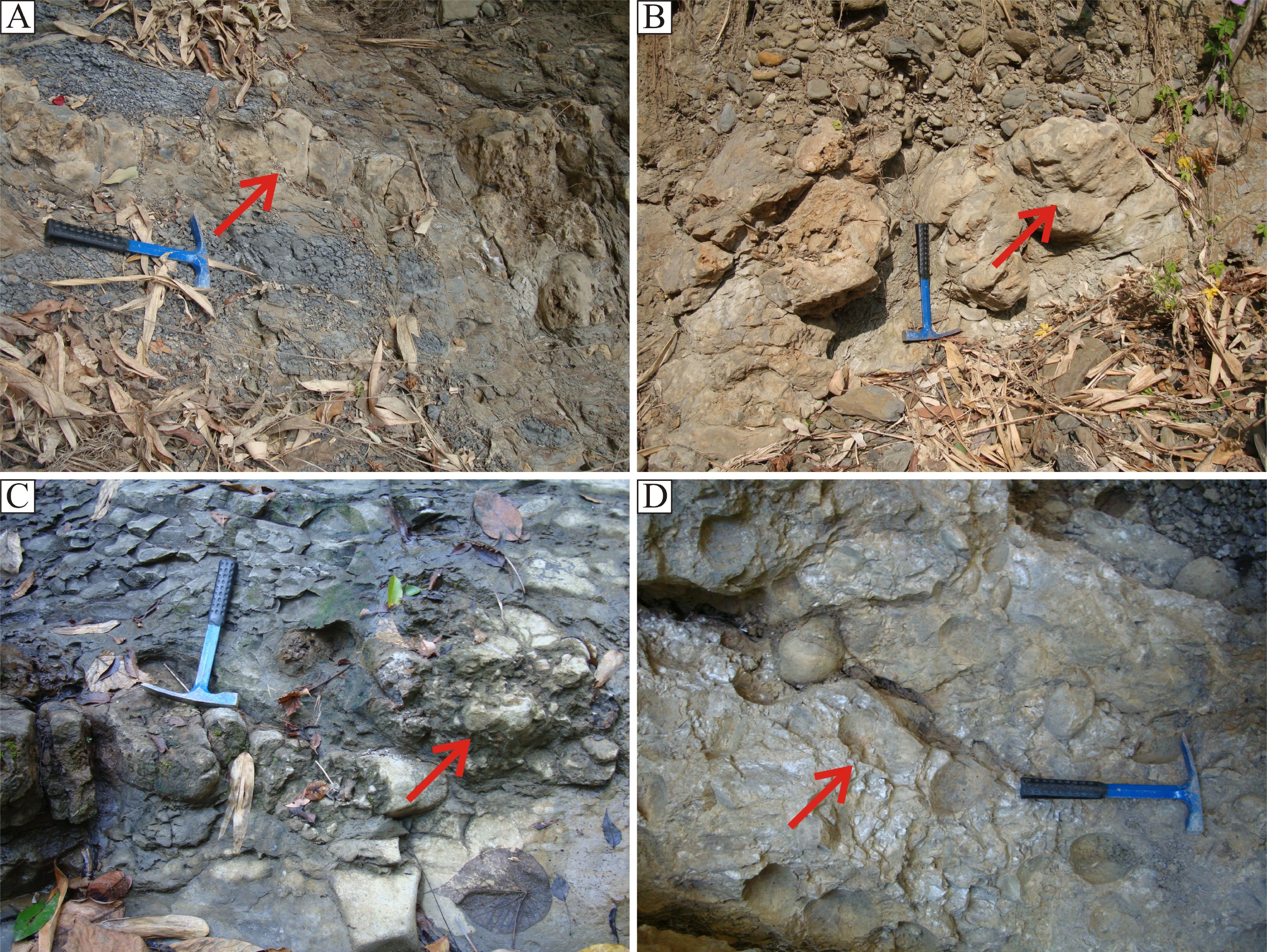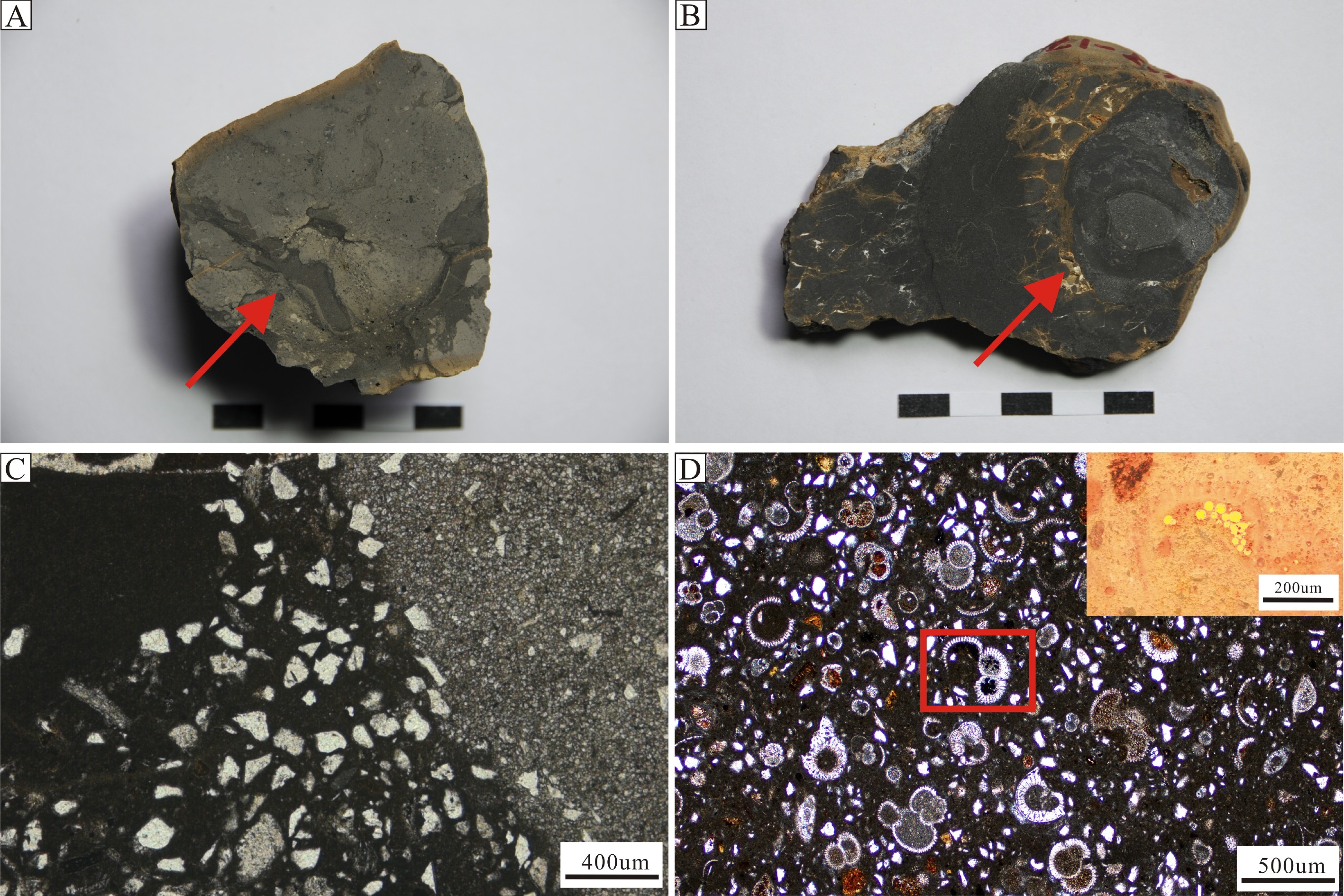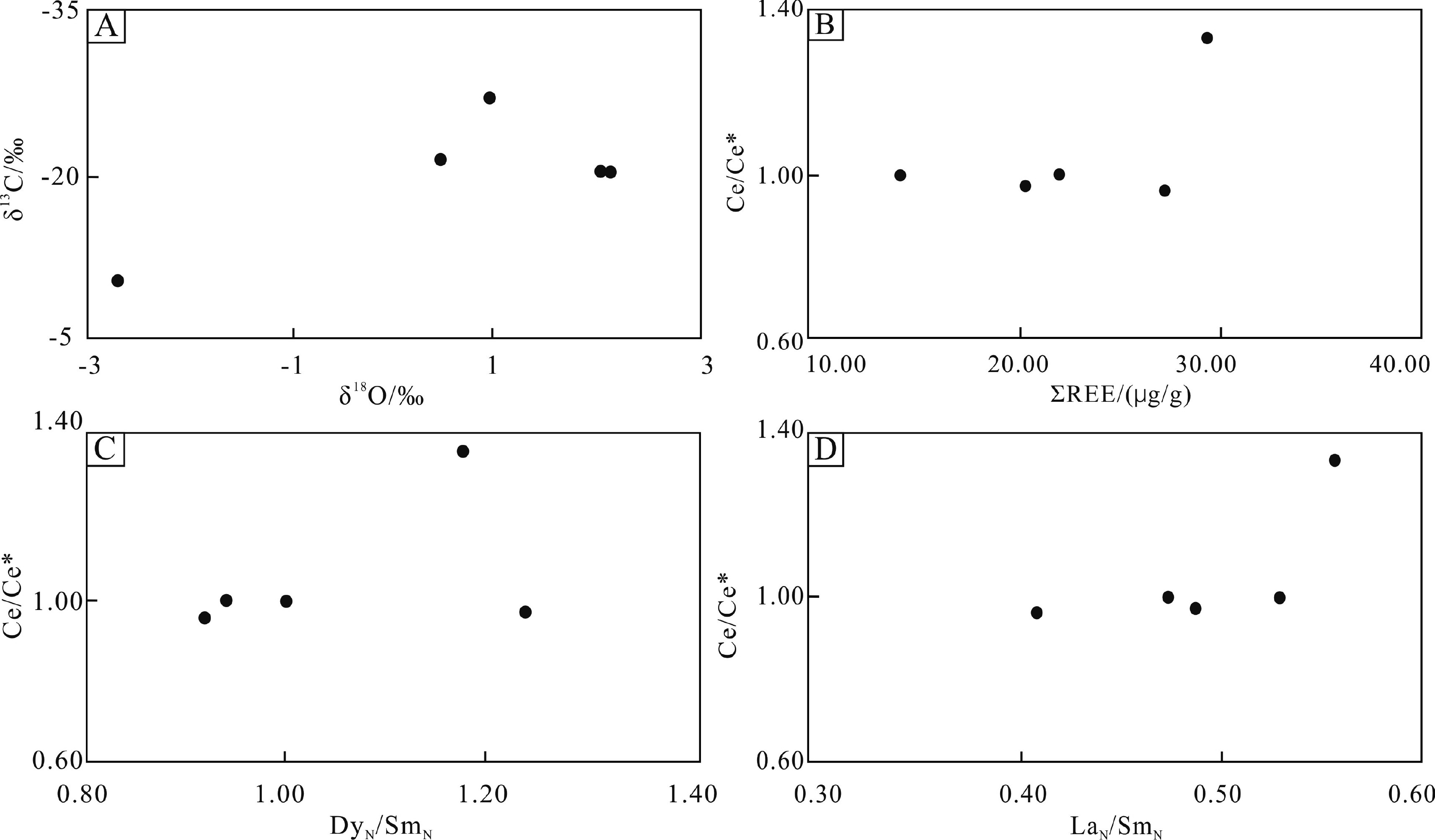Geochemical characteristics of the Early Pliocene cold seep dolomite at Chiahsien, Taiwan and their implications for fluid sources and sedimentary environment
-
摘要:
白云石成因一直是地学中尚未解决的难题,海底冷泉系统中发育的原生白云石为解决白云石成因问题提供了新途径。台湾甲仙白云仙谷早上新世盐水坑组页岩地层中发育有冷泉白云岩,其流体来源和沉积环境并不清楚。本文通过矿物学和岩石学,结合碳氧同位素、微量和稀土元素地球化学,探索该冷泉白云岩的流体特征和形成环境,为解决白云石成因提供参考。白云仙谷冷泉白云岩以烟囱状或透镜状产出于页岩中,碳酸盐矿物均为泥微晶白云石,含量为61.4%~88.0%。冷泉白云岩的δ13C为−27.08‰~−10.58‰,指示形成白云石的碳源可能是热成因甲烷和海水的混合。Ni/Co均值为12.54,稀土元素配分模式呈中稀土富集、无Ce异常,均表明冷泉白云岩形成于弱还原的沉积环境。在弱还原环境中的冷泉微生物的作用下,促进了HCO3−的增加和SO42−的消耗,可能有利于冷泉白云石的形成。
Abstract:The origin of dolomite is a long-term argument in geology. In recent years, protodolomite has been discovered in hydrocarbon seeps, which provides critical evidence for solving the problem. Therefore, the authigenic carbonate found in hydrocarbon seeps is regarded as a kind of unique geochemical archives of fluid seeping in history. The carbonates studied in this paper occur as chimneys or lenses within the shale of Early Pliocene, the Yanshuikeng Formation, exposed at Chiahsien, southwestern Taiwan. Petrological and geochemical tests, such as petrography, mineralogy, carbon and oxygen stable isotopes, and rare earth element (REE) compositions, are made to trace the fluid sources and sedimentary environment. X-ray analyses suggest that the carbonate is mainly composed of dolomite (61.4%~88.0%). The δ13C values of dolomites range from −27.08‰ V-PDB to −10.58‰ V-PDB, suggesting a thermogenic methane and seawater associated carbon sources. The value of Ni/Co is around 12.54, and the original REE distribution shows a pattern of enrichment in the middle without Ce anomalies. All these results indicate that the Chiahsien dolomite was precipitated from reducing seep fluids. Under the action of microorganisms in the sub-reducing environment, HCO3− is increased and the SO42− more consumed, which is in favor of the formation of seep dolomites.
-
Key words:
- seep dolomite /
- carbon isotope /
- REE /
- Taiwan
-

-
表 1 甲仙地区冷泉白云岩矿物学组成及碳氧同位素
Table 1. Mineralogical composition of the Chiahsien seep dolomite and carbon and oxygen isotope
样品号 方解石/% 白云石/% 石 英/% 伊利石/% 绿泥石+蒙脱石/% 钠长石/% δ13C/‰ δ18O/‰ BG-1 88.0 9.0 3.0 -20.42 2.06 BG-2 80.7 9.0 4.0 6.3 -20.48 1.98 BG-3 52.3 28.3 19.4 BG-4 82.7 12.9 4.3 -21.63 0.41 BG-5 83.6 7.8 4.0 4.6 BG-6 76.3 8.6 10.9 4.2 BG-7 73.8 6.5 13.1 4.0 2.6 BG-9 10.2 61.4 14.8 5.0 5.0 3.6 -10.62 -2.72 BG-10 78.7 13.4 7.9 BG-11 64.9 25.5 9.6 BG-12 78.7 9.5 11.8 -27.08 0.90 表 2 甲仙白云仙谷的冷泉白云岩的主量元素和微量元素含量
Table 2. Major and trace element compositions of the Chiahsien seep dolomite
样品号 BG-1 BG-2 BG-4 BG-9 BG-10 BG-11 BG-12 MnO/% 0.06 0.07 0.09 0.10 0.09 0.07 0.12 Sr/(μg/g) 291.16 296.37 226.96 218.85 408.65 244.33 394.45 Mn/Sr 2.53 2.89 4.86 5.60 2.70 3.51 3.73 Li/(μg/g) 4.20 2.95 3.03 4.53 3.28 2.42 3.27 Be/(μg/g) 1.27 0.74 0.84 0.91 1.09 0.97 1.09 Sc/(μg/g) 7.21 6.89 8.25 7.38 6.24 5.90 6.24 V/(μg/g) 6.28 4.66 13.00 10.10 13.10 10.10 13.10 Cr/(μg/g) 10.30 9.75 10.90 7.60 10.40 9.44 10.40 Co/(μg/g) 9.61 2.06 3.26 2.89 3.59 3.38 3.59 Ni/(μg/g) 51.70 49.60 49.70 38.70 44.60 35.00 44.60 Cu/(μg/g) 0.48 0.36 0.40 1.26 0.61 1.02 0.61 Zn/(μg/g) 3.20 1.94 2.09 1.72 5.71 0.09 5.71 Ga/(μg/g) 0.39 0.43 0.45 0.56 0.52 0.41 0.83 Rb/(μg/g) 4.41 3.73 4.63 5.69 3.41 2.92 7.20 Zr/(μg/g) 0.23 0.31 0.34 0.17 0.66 0.37 1.16 Nb/(μg/g) 0.03 0.02 0.03 0.01 0.04 0.03 0.20 Cs/(μg/g) 0.04 0.05 0.05 0.05 0.05 0.04 0.19 Ba/(μg/g) 23.00 16.00 22.00 18.00 23.00 20.00 32.00 Hf/(μg/g) 0.03 0.02 0.02 0.03 0.03 0.03 0.05 Pb/(μg/g) 0.04 0.24 0.21 0.37 0.49 0.19 0.23 Th/(μg/g) 1.20 1.10 1.84 3.16 1.26 1.51 1.52 U/(μg/g) 0.63 0.55 4.61 0.53 2.32 5.77 0.78 Ni/Co 5.38 24.08 15.25 13.39 12.42 10.36 12.79 表 3 甲仙白云仙谷的冷泉白云岩的稀土元素含量
Table 3. Rare element compositions of the Chiahsien seep dolomite
样品号 BG-1 BG-2 BG-4 BG-9 BG-12 La/(μg/g) 3.28 2.16 3.64 4.16 4.54 Ce/(μg/g) 7.36 5.21 8.58 10.08 13.5 Pr/(μg/g) 0.9 0.67 1.05 1.34 1.03 Nd/(μg/g) 3.93 2.83 4.49 6.09 4.95 Sm/(μg/g) 0.97 0.66 0.99 1.48 1.17 Eu/(μg/g) 0.3 0.19 0.29 0.45 0.37 Gd/(μg/g) 1.24 0.77 1.17 1.67 1.48 Tb/(μg/g) 0.17 0.1 0.16 0.23 0.21 Dy/(μg/g) 1.01 0.52 0.83 1.14 1.15 Y/(μg/g) 9.03 4.52 7.41 7.75 10.2 Ho/(μg/g) 0.18 0.09 0.15 0.18 0.22 Er/(μg/g) 0.52 0.24 0.39 0.49 0.62 Tm/(μg/g) 0.06 0.03 0.04 0.06 0.08 Yb/(μg/g) 0.4 0.17 0.25 0.33 0.51 Lu/(μg/g) 0.06 0.02 0.03 0.04 0.08 ΣREE/(μg/g) 20.37 13.66 22.06 27.74 29.91 Ce/Ce* 0.97 1.00 1.00 0.96 1.33 lg(Ce/Ce*) 0.02 0.00 0.00 0.02 0.12 Pr/Pr* 0.98 1.02 0.99 0.99 0.74 (Pr/Sm)N 0.58 0.64 0.67 0.57 0.55 (Sm/Yb)N 1.24 2.03 2.02 2.30 1.16 -
[1] Land L S. Failure to precipitate dolomite at 25 ℃ from dilute solution despite 1000-Fold Oversaturation after 32 Years [J]. Aquatic Geochemistry, 1998, 4(3-4): 361-368.
[2] Ning M, Lang X G, Huang K J, et al. Towards understanding the origin of massive dolostones [J]. Earth and Planetary Science Letters, 2020, 545: 116403. doi: 10.1016/j.jpgl.2020.116403
[3] Graf D L, Goldsmith J R. Some hydrothermal syntheses of dolomite and protodolomite [J]. The Journal of Geology, 1956, 64(2): 173-186. doi: 10.1086/626332
[4] 卞友艳, 陈多福. 海底冷泉环境中的白云石(岩)研究现状[J]. 矿物岩石地球化学通报, 2014, 32(2):238-246 doi: 10.3969/j.issn.1007-2802.2014.02.012
BIAN Youyan, CHEN Duofu. Research progress of dolomite in seep carbonates [J]. Bulletin of Mineralogy, Petrology and Geochemistry, 2014, 32(2): 238-246. doi: 10.3969/j.issn.1007-2802.2014.02.012
[5] Li W Q, Bialik O M, Wang X M, et al. Effects of early diagenesis on Mg isotopes in dolomite: The roles of Mn(IV)-reduction and recrystallization [J]. Geochimica et Cosmochimica Acta, 2019, 250: 1-17. doi: 10.1016/j.gca.2019.01.029
[6] Adams J E, Rhodes M L. Dolomitization by seepage refluxion [J]. AAPG Bulletin, 1960, 44(12): 1912-1920.
[7] Sherman G D, Kanehiro Y, Fujimoto C K. Dolomitization in semi-arid Hawaiian Soils [J]. Pacific Science, 1947, 1(1): 38-44.
[8] Müller D W, McKenzie J A, Mueller P A. Abu dhabi Sabkha, persian gulf, revisited: application of strontium isotopes to test an early dolomitization model [J]. Geology, 1990, 18(7): 618-621. doi: 10.1130/0091-7613(1990)018<0618:ADSPGR>2.3.CO;2
[9] 由雪莲, 孙枢, 朱井泉, 等. 微生物白云岩模式研究进展[J]. 地学前缘, 2011, 18(4):52-64
YOU Xuelian, SUN Shu, ZHU Jingquan, et al. Progress in the study of microbial dolomite model [J]. Earth Science Frontiers, 2011, 18(4): 52-64.
[10] 甯濛, 黄康俊, 沈冰. 镁同位素在“白云岩问题”研究中的应用及进展[J]. 岩石学报, 2018, 34(12):3690-3708
NING Meng, HUANG Kangjun, SHEN Bing. Applications and advances of the magnesium isotope on the ‘dolomite problem’ [J]. Acta Petrologica Sinica, 2018, 34(12): 3690-3708.
[11] Petrash D A, Bialik O M, Bontognali T R R, et al. Microbially catalyzed dolomite formation: From near-surface to burial [J]. Earth-Science Reviews, 2017, 171: 558-582. doi: 10.1016/j.earscirev.2017.06.015
[12] Vasconcelos C, McKenzie J A, Bernasconi S, et al. Microbial mediation as a possible mechanism for natural dolomite formation at low temperatures [J]. Nature, 1995, 377(6546): 220-222. doi: 10.1038/377220a0
[13] Meister P, Gutjahr M, Frank M, et al. Dolomite formation within the methanogenic zone induced by tectonically driven fluids in the Peru accretionary prism [J]. Geology, 2011, 39(6): 563-566. doi: 10.1130/G31810.1
[14] Moore T S, Murray R W, Kurtz A C, et al. Anaerobic methane oxidation and the formation of dolomite [J]. Earth and Planetary Science Letters, 2004, 229(1-2): 141-154. doi: 10.1016/j.jpgl.2004.10.015
[15] Zhang C L, Lanoil B. Geomicrobiology and biogeochemistry of gas hydrates and cold seeps [J]. Chemical Geology, 2004, 205(3-4): 187-194. doi: 10.1016/j.chemgeo.2004.01.001
[16] 李波, 颜佳新, 刘喜停, 等. 白云岩有机成因模式: 机制、进展与意义[J]. 古地理学报, 2010, 12(6):699-710 doi: 10.7605/gdlxb.2010.06.006
LI Bo, YAN Jiaxin, LIU Xiting, et al. The organogenic dolomite model: mechanism, progress and significance [J]. Journal of Palaeogeography, 2010, 12(6): 699-710. doi: 10.7605/gdlxb.2010.06.006
[17] Chang B, Li C, Liu D, et al. Massive formation of early diagenetic dolomite in the Ediacaran ocean: Constraints on the "dolomite problem" [J]. Proceedings of the National Academy of Sciences of the United States of America, 2020, 117(25): 14005-14014. doi: 10.1073/pnas.1916673117
[18] Tong H P, Feng D, Peckmann J, et al. Environments favoring dolomite formation at cold seeps: A case study from the Gulf of Mexico [J]. Chemical Geology, 2019, 518: 9-18. doi: 10.1016/j.chemgeo.2019.04.016
[19] Wang Q X, Tong H P, Huang C Y, et al. Tracing fluid sources and formation conditions of Miocene hydrocarbon-seep carbonates in the central Western Foothills, Central Taiwan [J]. Journal of Asian Earth Sciences, 2018, 168: 186-196. doi: 10.1016/j.jseaes.2017.11.015
[20] 陈多福, 陈先沛, 陈光谦. 冷泉流体沉积碳酸盐岩的地质地球化学特征[J]. 沉积学报, 2002, 20(1):34-40 doi: 10.3969/j.issn.1000-0550.2002.01.007
CHEN Duofu, CHEN Xianpei, CHEN Guangqian. Geology and geochemistry of cold seepage and venting-related carbonates [J]. Acta Sedimentologica Sinica, 2002, 20(1): 34-40. doi: 10.3969/j.issn.1000-0550.2002.01.007
[21] Deng Y N, Chen F, Hu Y, et al. Methane seepage patterns during the middle Pleistocene inferred from molybdenum enrichments of seep carbonates in the South China Sea [J]. Ore Geology Reviews, 2020, 125: 103701. doi: 10.1016/j.oregeorev.2020.103701
[22] Campbell K A. Hydrocarbon seep and hydrothermal vent paleoenvironments and paleontology: Past developments and future research directions [J]. Palaeogeography, Palaeoclimatology, Palaeoecology, 2006, 232(2-4): 362-407. doi: 10.1016/j.palaeo.2005.06.018
[23] Sun Z L, Wu N Y, Cao H, et al. Hydrothermal metal supplies enhance the benthic methane filter in oceans: An example from the Okinawa Trough [J]. Chemical Geology, 2019, 525: 190-209. doi: 10.1016/j.chemgeo.2019.07.025
[24] Thiagarajan N, Crémière A, Blättler C, et al. Stable and clumped isotope characterization of authigenic carbonates in methane cold seep environments [J]. Geochimica et Cosmochimica Acta, 2020, 279: 204-219. doi: 10.1016/j.gca.2020.03.015
[25] Deng S C, Dong H L, Lv G, et al. Microbial dolomite precipitation using sulfate reducing and halophilic bacteria: Results from Qinghai Lake, Xizang Plateau, NW China [J]. Chemical Geology, 2010, 278(3-4): 151-159. doi: 10.1016/j.chemgeo.2010.09.008
[26] Van Lith Y, Warthmann R, Vasconcelos C, et al. Microbial fossilization in carbonate sediments: a result of the bacterial surface involvement in dolomite precipitation [J]. Sedimentology, 2003, 50(2): 237-245. doi: 10.1046/j.1365-3091.2003.00550.x
[27] Naehr T H, Eichhubl P, Orphan V J, et al. Authigenic carbonate formation at hydrocarbon seeps in continental margin sediments: A comparative study [J]. Deep Sea Research Part II: Topical Studies in Oceanography, 2007, 54(11-13): 1268-1291. doi: 10.1016/j.dsr2.2007.04.010
[28] Huang C Y, Wu W Y, Chang C P, et al. Tectonic evolution of accretionary prism in the arc-continent collision terrane of Taiwan [J]. Tectonophysics, 1997, 281(1-2): 31-51. doi: 10.1016/S0040-1951(97)00157-1
[29] Bowin C, Lu R S, Lee C S, et al. Plate convergence and accretion in Taiwan-Luzon region [J]. AAPG Bulletin, 1978, 62(9): 1645-1672.
[30] Huang C Y, Shyu C T, Lin S B, et al. Marine geology in the arc-continent collision zone off southeastern Taiwan: Implications for late neogene evolution of the coastal range [J]. Marine Geology, 1992, 107(3): 183-212. doi: 10.1016/0025-3227(92)90167-G
[31] 陈文煌, 黄奇瑜, 林彦均, 等. 台湾东部海岸山脉乐合弧前盆地层序: 记录活跃斜向弧陆碰撞之构造演化[J]. 大地构造与成矿学, 2015, 39(6):992-1007
CHEN Wenhuang, HUANG Chiyue, LIN Yanjun, et al. Stratigraphy of the loho forearc basin in the coastal range, Eastern Taiwan: recording tectonic evolution of active oblique arc-continent collision [J]. Geotectonica et Metallogenia, 2015, 39(6): 992-1007.
[32] Wang S E, Gong S Y, Mli H S, et al. Cold-seep carbonate hardgrounds as the initial substrata of coral reef development in a siliciclastic paleoenvironment of southwestern Taiwan [J]. Terrestrial Atmospheric and Oceanic Sciences, 2006, 17(2): 405-427. doi: 10.3319/TAO.2006.17.2.405(TT)
[33] Huang C Y, Chien C W, Zhao M X, et al. Geological study of active cold seeps in the syn-collision accretionary prism Kaoping slope off SW Taiwan [J]. Terrestrial, Atmospheric and Oceanic Sciences, 2006, 17(4): 679-702. doi: 10.3319/TAO.2006.17.4.679(GH)
[34] Chien C W, Huang C Y, Lee H C, et al. Patterns and sizes of authigenic carbonate formation in the pliocene foreland in Southwestern Taiwan: implications of an ancient methane seep [J]. Terrestrial Atmospheric and Oceanic Sciences, 2013, 24(6): 971-984. doi: 10.3319/TAO.2013.07.05.01(TT)
[35] 中央经济部中央地质调查所. 1: 50000地质图(甲仙幅, 2000)[M]. 台北: 台湾中央经济部中央地质调查所, 2000.
Central Geological Survey. Geologic Map of Taiwan, 1: 50000(Chiahsien, 2000)[M]. Taipei: Central Geological Survey, Ministry of Economic Affairs.
[36] 簡至暐. 臺灣西南部西部麓山帶甲仙地區上新世古冷泉自生性碳酸鹽及其有孔蟲群集之研究[D]. 國立成功大學, 2014.
Chien C W. Study of authigenic carbonates and associated foraminiferal assemblages in the pliocene paleoseeps of Chiahsien area in Western Foothills southwestern Taiwan[D]. National Cheng Kung University, 2014.
[37] 赵彦彦, 郑永飞. 碳酸盐沉积物的成岩作用[J]. 岩石学报, 2010, 27(2):501-509
ZHAO Yanyan, ZHENG Yongfei. Diagenesis of carbonate sediments [J]. Acta Petrologica Sinica, 2010, 27(2): 501-509.
[38] Shields G, Stille P. Diagenetic constraints on the use of cerium anomalies as palaeoseawater redox proxies: an isotopic and REE study of Cambrian phosphorites [J]. Chemical Geology, 2001, 175(1-2): 29-48. doi: 10.1016/S0009-2541(00)00362-4
[39] Chen D F, Wei Q D, Liang Q, et al. Possible REE constraints on the depositional and diagenetic environment of Doushantuo Formation phosphorites containing the earliest metazoan fauna [J]. Chemical Geology, 2003, 201(1-2): 103-118. doi: 10.1016/S0009-2541(03)00235-3
[40] Chien C W, Huang C Y, Chen Z, et al. Miocene shallow-marine cold seep carbonate in fold-and-thrust Western Foothills, SW Taiwan [J]. Journal of Asian Earth Sciences, 2012, 56: 200-211. doi: 10.1016/j.jseaes.2012.05.013
[41] 佟宏鹏, 陈多福. 西藏日喀则晚白垩世冷泉碳酸盐岩的发现及其特征[J]. 科学通报, 2012, 57(33):4363-4372 doi: 10.1007/s11434-012-5434-2
TONG Hongpeng, CHEN Duofu. First discovery and characterizations of late Cretaceous seep carbonates from Xigaze in Xizang, China [J]. Chinese Science Bulletin, 2012, 57(33): 4363-4372. doi: 10.1007/s11434-012-5434-2
[42] 张文进, 王钦贤, 陈多福. 西藏岗巴地区晚白垩世冷泉碳酸盐岩地球化学特征及其对流体来源及沉积环境的示踪[J]. 地球化学, 2018, 47(2):217-227 doi: 10.3969/j.issn.0379-1726.2018.02.010
ZHANG Wenjin, WANG Qinxian, CHEN Duofu. Implications of fluid source and sedimentary environment from the sedimentary geochemistry of Late Cretaceous cold seep carbonates from Gamba, Xizang [J]. Geochimica, 2018, 47(2): 217-227. doi: 10.3969/j.issn.0379-1726.2018.02.010
[43] Bian Y Y, Feng D, Roberts H H, et al. Tracing the evolution of seep fluids from authigenic carbonates: Green Canyon, northern Gulf of Mexico [J]. Marine and Petroleum Geology, 2013, 44(3): 71-81.
[44] Wignall P B, Myers K J. Interpreting benthic oxygen levels in mudrocks: A new approach [J]. Geology, 1988, 16(5): 452-455. doi: 10.1130/0091-7613(1988)016<0452:IBOLIM>2.3.CO;2
[45] Algeo T J, Maynard J B. Trace-element behavior and redox facies in core shales of Upper Pennsylvanian Kansas-type cyclothems [J]. Chemical Geology, 2004, 206(3-4): 289-318. doi: 10.1016/j.chemgeo.2003.12.009
[46] Calvert S E, Pedersen T F. Geochemistry of Recent oxic and anoxic marine sediments: Implications for the geological record [J]. Marine Geology, 1993, 113(1-2): 67-88. doi: 10.1016/0025-3227(93)90150-T
[47] 林治家, 陈多福, 刘芊. 海相沉积氧化还原环境的地球化学识别指标[J]. 矿物岩石地球化学通报, 2008, 27(1):72-80 doi: 10.3969/j.issn.1007-2802.2008.01.012
LIN Zhijia, CHEN Duofu, LIU Qian. Geochemical indices for redox conditions of marine sediments [J]. Bulletin of Mineralogy, Petrology and Geochemistry, 2008, 27(1): 72-80. doi: 10.3969/j.issn.1007-2802.2008.01.012
[48] Jones B, Manning D A C. Comparison of geochemical indices used for the interpretation of palaeoredox conditions in ancient mudstones [J]. Chemical Geology, 1994, 111(1-4): 111-129. doi: 10.1016/0009-2541(94)90085-X
[49] 常华进, 储雪蕾, 冯连君, 等. 氧化还原敏感微量元素对古海洋沉积环境的指示意义[J]. 地质论评, 2009, 55(1):91-99 doi: 10.3321/j.issn:0371-5736.2009.01.011
CHANG Huajin, CHU Xuelei, FENG Lianjun, et al. Redox sensitive trace elements as paleoenvironments proxies [J]. Geological Review, 2009, 55(1): 91-99. doi: 10.3321/j.issn:0371-5736.2009.01.011
[50] 王宇航, 朱园园, 黄建东, 等. 海相碳酸盐岩稀土元素在古环境研究中的应用[J]. 地球科学进展, 2018, 33(9):922-932 doi: 10.11867/j.issn.1001-8166.2018.09.0922
WANG Yuhang, ZHU Yuanyuan, HUANG Jiandong, et al. Application of rare earth elements of the marine carbonate rocks in paleoenvironmental researches [J]. Advances in Earth Science, 2018, 33(9): 922-932. doi: 10.11867/j.issn.1001-8166.2018.09.0922
[51] Kim J H, Torres M E, Haley B A, et al. The effect of diagenesis and fluid migration on rare earth element distribution in pore fluids of the northern Cascadia accretionary margin [J]. Chemical Geology, 2012, 291: 152-165. doi: 10.1016/j.chemgeo.2011.10.010
[52] Wang Q X, Chen D F, Peckmann J. Iron shuttle controls on molybdenum, arsenic, and antimony enrichment in Pliocene methane-seep carbonates from the southern Western Foothills, Southwestern Taiwan [J]. Marine and Petroleum Geology, 2019, 100: 263-269. doi: 10.1016/j.marpetgeo.2018.11.011
[53] Hu Y, Feng D, Peckmann J, et al. New insights into cerium anomalies and mechanisms of trace metal enrichment in authigenic carbonate from hydrocarbon seeps [J]. Chemical Geology, 2014, 381: 55-66. doi: 10.1016/j.chemgeo.2014.05.014
[54] 卞友艳, 林治家, 冯东, 等. 冷泉碳酸盐岩的稀土元素地球化学特征及氧化还原条件示踪[J]. 热带海洋学报, 2012, 31(5):37-44 doi: 10.3969/j.issn.1009-5470.2012.05.006
BIAN Youyan, LIN Zhijia, FENG Dong, et al. Rare earth elements of seep carbonates and using them to trace redox variation at seep sites [J]. Journal of Tropical Oceanography, 2012, 31(5): 37-44. doi: 10.3969/j.issn.1009-5470.2012.05.006
[55] Wang S H, Yan W, Chen Z, et al. Rare earth elements in cold seep carbonates from the southwestern Dongsha area, northern South China Sea [J]. Marine and Petroleum Geology, 2014, 57: 482-493. doi: 10.1016/j.marpetgeo.2014.06.017
[56] Rongemaille E, Bayon G, Pierre C, et al. Rare earth elements in cold seep carbonates from the Niger delta [J]. Chemical Geology, 2011, 286(3-4): 196-206.
[57] 张学丰, 胡文瑄, 张军涛. 白云岩成因相关问题及主要形成模式[J]. 地质科技情报, 2006, 25(5):32-40 doi: 10.3969/j.issn.1000-7849.2006.05.006
ZHANG Xuefeng, HU Wenxuan, ZHANG Juntao. Critical problems for dolomite formation and dolomitization models [J]. Geological Science and Technology Information, 2006, 25(5): 32-40. doi: 10.3969/j.issn.1000-7849.2006.05.006
[58] Lu Y, Liu Y F, Sun X M, et al. Intensity of methane seepage reflected by relative enrichment of heavy magnesium isotopes in authigenic carbonates: A case study from the South China Sea [J]. Deep Sea Research Part I: Oceanographic Research Papers, 2017, 129: 10-21. doi: 10.1016/j.dsr.2017.09.005
[59] Nelson C S, Nyman S L, Campbell K A, et al. Influence of faulting on the distribution and development of cold seep-related dolomitic conduit concretions at East Cape, New Zealand [J]. New Zealand Journal of Geology and Geophysics, 2017, 60(4): 478-496. doi: 10.1080/00288306.2017.1372489
[60] Bau M, Dulski P. Distribution of yttrium and rare-earth elements in the Penge and Kuruman iron-formations, Transvaal Supergroup, South Africa [J]. Precambrian Research, 1996, 79(1-2): 37-55. doi: 10.1016/0301-9268(95)00087-9
-




 下载:
下载:



